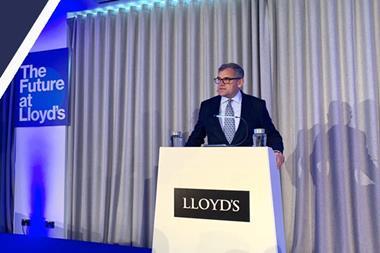The Lloyd’s market has announced its blueprint for the future less than a week after the results of its survey into the culture of the market and its interim results, which highlighted there is still work to do
History is littered with salutary lessons of what happens when you fight a war in two fronts.
Therefore, Lloyd’s decision seeking to deliver on three major initiative simultaneously can be viewed as either ambitious or foolhardy.
This week has seen the launch of the market’s blueprint for the future. Its six core initiatives are designed to streamline the process of placing business via electric platforms, speed up claims settlements and attract new capital.
Lloyd’s Chairman Bruce Carnegie-Brown explained the creation of a risk exchange for packaged risks will enable the market to underwrite risks that at present are simply uneconomical.
“It has not been a question that we have not wanted to underwrite motor insurance for instance,” he explained. “It has simply been a case that we have not been able to do so at a price which is competitive. The aim of the risk exchange is to allow the market to write business which traditionally it has not been able to access.”
Carnegie-Brown added that while the blueprint launch will signal the start of the process there will be some degree of flexibility along the way.
“This is version one of the blueprint and we will have future versions as the work to deliver the changes we require is delivered,” he added.
Questions remain
However, while the moves have been welcomed by many there are those who have been involved in the market’s process reform efforts for many years who think the plan must fundamentally change the market not simply look to modernise the old ways of doing things.
Kirstin Duffield managing director at Morning Data told Insurance Times: “Questions remain. What we need are open source APIs and unambiguous market data standards that will allow systems to access Lloyd’s. I am concerned that the market is still not looking at how the business should be transacted but rather continuing to build on old processes and is basing its blueprint on how that can be adapted not joined up.”
There is concern for the future of the various London market initiatives to date under the TOM programme, which have cost millions to develop and implement and some in the market say that they have been effectively side-lined as Lloyd’s looks to drive its blueprint under a new guard.
While technology can reduce frictional costs, Lloyd’s has redoubled its efforts to eradicate poorly performing business.
Decile 10
It caused waves late last year when it announced that it would be looking at the lowest performing ten percent of each syndicates business and questioning if such business should be underwritten in the market.
The result has been a withdrawal of capacity from some lines, particularly the marine classes, and that work is to continue into 2020 and beyond.
Jon Hancock Performance Management Director has said the market is determined to ensure that the risks it underwrites are of the requisite quality and at the right price.
“We will discuss the issue with the syndicates as they plan for 2020,” he said. “Those syndicates who are in the top quartile will have less of a focus than those in the bottom quartile. This is all about ensuring the quality of what we are writing.
“It is not simply a case of looking at a percentile. We want to work with the syndicates to ensure that bad risks do not hamper performance.”
The past week has seen Lloyd’s not only unveil its blueprint but also the results of the survey into the market’s culture, which found excessive drinking and inappropriate behaviour such as sexual harassment is still an issue.
Culture challenge
Lloyd’s chief exceutive, John Neal said as he launched the report: “It is not easy to read and not easy to say. We have heard from women who have talked of bullying, harassment and worse, and it is still going on in an unspoken way. It is not the market I know.”
Neal said: “We need to calculate the progress made, but there is much to do. It starts by ensuring that Lloyd’s is a safe and inclusive place to work.”
He warned that the market had a range of sanctions it could impose but added that it was not just individuals but companies that needed to up their game and ensure that the market’s culture was implemented.
The market will set gender balance targets for boards, executive committees and their direct reports and these will be monitored.
When asked how far he was prepared to sanction those who fail to meet those standards Neal replied: “All the way. Individual operations who won’t move to our drumbeat cannot be part of our community. There are no excuses and if we do not get to where we want to be then we need to take the ultimate sanction.”
There are those who say that the market is being too ambitious in pushing ahead with three major initiatives each one of which has the potential to change the way the market operates on different levels.
However, Neal said in the market leadership’s eyes it was in effect all or nothing.
“Delivering two out of three will not be seen as a success,” he explained.
Lloyd’s Interim Results 2019
Why were they so important this year?
They are seen as a first litmus test of the new approach from the market to look to eradicate the lowest performing decile of each syndicate’s business for the 2019 underwriting year.
Did they deliver?
A profit of £600 million for the first half of 2018 had been turned into a figure of £2.3 billion. On the face of it the tough stance from the market was having a real effect but a delve into the detail painted a less rosy picture. The market’s combined ratio was up on the corresponding period as was its gross written premium, despite the clampdown on the lowest performing decile.
But they still made a £2.3 billion profit
While investment returns contributed £200 million to the 2018 interim profit of £600 million. Investment returns equalled the entire £2.3 billion of this year’s profit.
So has the market seen any impact form its tough stance on lower performing business?
Lloyd’s said the figures needed to be put into context. It said the elimination of foreign exchange rate movements and growth from new syndicates points to a like-for-like year-on-year reduction in premiums of 2.6%. This is the net impact of a 6.5% reduction in business volumes as underwriters adjusted their books to improve performance and average risk adjusted rate increases of 3.9%.
Hosted by comedian and actor Tom Allen, 34 Gold, 23 Silver and 22 Bronze awards were handed out across an amazing 34 categories recognising brilliance and innovation right across the breadth of UK general insurance.





















































No comments yet